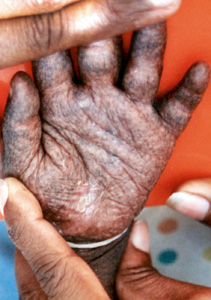In the eye of the storm in recent months, has been arsenic, the chemical element which is described as an “extremely poisonous white powder”.
Explaining that this “very toxic” substance which is tasteless and odourless is found in the earth but not in high levels, Prof. Ravindra Fernando, Senior Professor of Forensic Medicine and Toxicology of the Colombo Medical Faculty, points out, however, that in some countries like Bangladesh there is a major problem as the groundwater has a high content of arsenic.
 |
| Skin pigmentation of the hand with arsenic poisoning after ingestion of an
ayurvedic preparation with arsenic |
Seafood, beer, drinking water, table salt, tobacco smoke, laundry detergent, bone meal, dolomite and kelp (a type of plant) contain small amounts of arsenic, says this poison specialist, adding that certain ayurvedic preparations may also have arsenic.
Arsenic poisoning, according to Prof. Fernando, could be in “acute form”, where symptoms occur immediately after ingestion or “chronic form” where symptoms come over a period of time. Arsenic absorption to the human body takes place mainly from the small intestine when a person has eaten or drunk something which contains this chemical. Minimal absorption may occur from skin contact and inhalation.
Headaches, confusion, drowsiness and convulsions follow arsenic poisoning, with the other manifestations being vomiting, diarrhoea, kidney, liver and lung problems, leading to a coma and death in extreme cases, MediScene learns.
Decades ago sodium arsenite was a widely-used weedicide in Sri Lanka, while arsenic was also imported, packeted and sold as a rat-killer. However, now as these products have been banned, we don’t see acute arsenic poisoning, says Prof. Fernando, adding that there does not seem to be adequate scientific evidence to prove that the chronic kidney disease gripping the Dry Zone is due to arsenic in rice.
Citing the common symptoms of arsenic poisoning, he says externally the patient would be dehydrated while internally the stomach and the intestines would be empty, both due to the heavy vomiting and diarrhoea. The large bowels would indicate watery stools like in cholera.
“The early features of arsenic poisoning could also include a burning sensation in the throat (oesophagus) and abdominal pain while there may be a garlic odour in the patient’s breath as well as the stools. These could be accompanied by headache, dizziness, muscle spasm and delirium,” he says.
The extensive fluid loss due to vomiting and diarrhoea could lead to:
- Hypovolaemic shock (severe blood and fluid loss which makes the heart unable to pump enough blood to the body, leading to vital organs packing up)
- Cold and clammy skin
- Hypotension (low blood pressure)
- Oliguria (low output of urine)
- Tachycardia (the heart starts beating too fast)
- The rare manifestation of pulmonary oedema (fluid in the lung)
Shock, convulsions and coma can lead to death, says Prof. Fernando who has not only devoted a section of his book on ‘Management of Poisoning’ to arsenic but also written a chapter on ‘Attempted homicide with arsenic’ for a publication on Clinical Toxicology in 1979.
Dealing with “prolonged exposure” to arsenic, he adds that the tell-tale features could be peripheral neuropathy (damage to nerves), white transverse bands in the nails (Mee’s lines), brittle nails, hyperkeratosis (thickening of the skin) of palms and soles, changes of skin pigmentation (colour) and loss of hair.
The antidotes for arsenic are chelating agents for patients without life-threatening poisoning, he adds.
Interesting facts
from the web
- Arsenic trioxide is used to bring about remission in those suffering from acute promyelocytic leukaemia
- Ancient Greek physicians Hippocrates and Galen used arsenic as a healing agent.
- In the past, Fowler’s solution (1% arsenic trioxide preparation) called a “health tonic” had also been used to treat leukaemia, skin conditions such as psoriasis, dermatitis herpetiformis and eczema and stomatitis and gingivitis in infants
- A light yellow compound containing 30% arsenic had been used intravenously to treat syphilis, yaws and some protozoan infections. Arsenic had been the primary treatment for syphilis until World War II.
|
